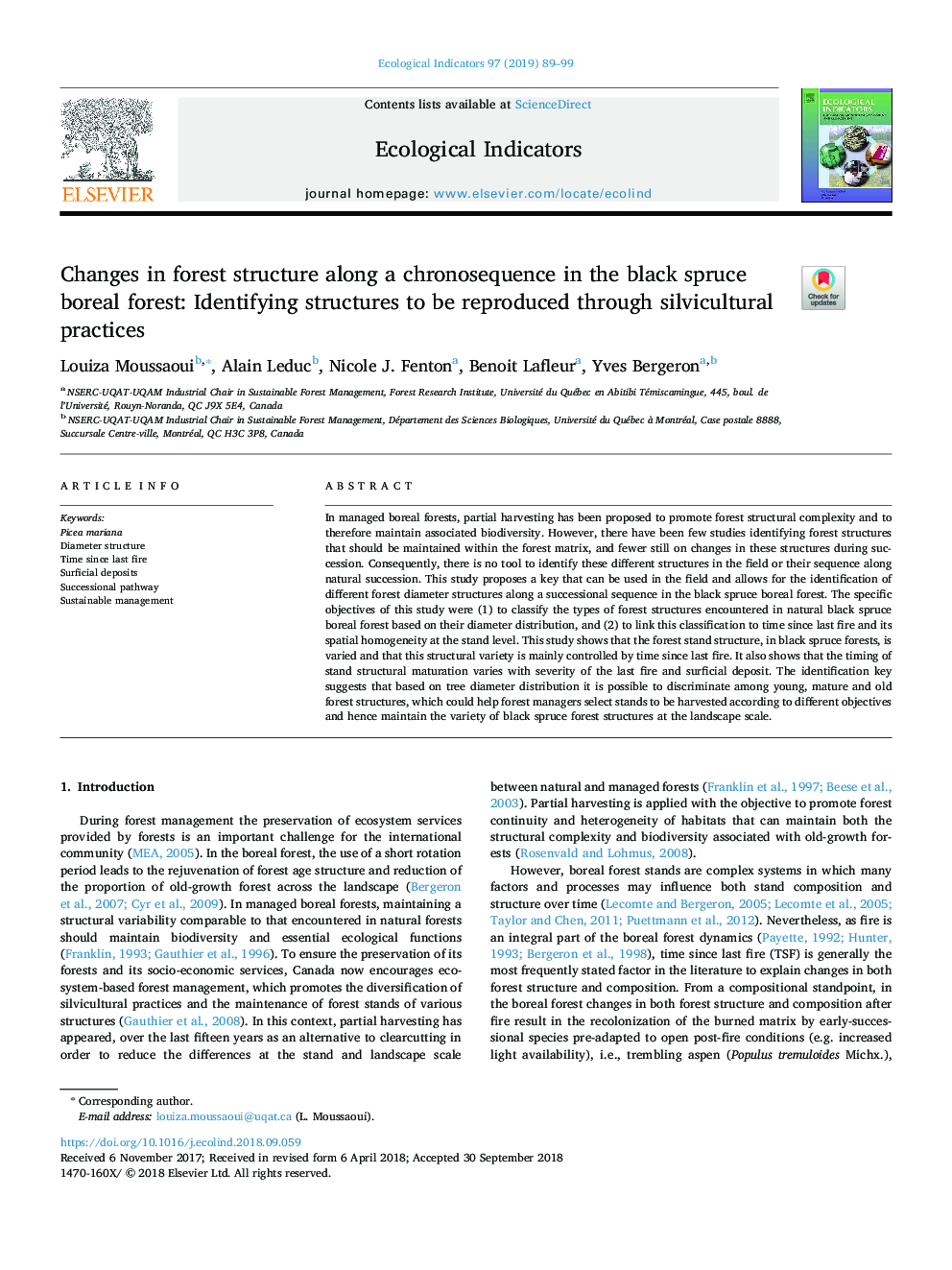| کد مقاله | کد نشریه | سال انتشار | مقاله انگلیسی | نسخه تمام متن |
|---|---|---|---|---|
| 11010272 | 1810984 | 2019 | 11 صفحه PDF | دانلود رایگان |
عنوان انگلیسی مقاله ISI
Changes in forest structure along a chronosequence in the black spruce boreal forest: Identifying structures to be reproduced through silvicultural practices
ترجمه فارسی عنوان
تغییرات در ساختار جنگل در طول کروموزوم در جنگل های سیاه و سفید صنوبر سیاه پوست: شناسایی سازه های تولید شده از طریق شیوه های کشاورزی
دانلود مقاله + سفارش ترجمه
دانلود مقاله ISI انگلیسی
رایگان برای ایرانیان
ترجمه چکیده
در جنگل های دو طرفه مدیریت شده، برداشت جزئی برای پیشبرد پیچیدگی ساختاری جنگل پیشنهاد شده است و بنابراین تنوع زیستی مرتبط با آن حفظ شده است. با این حال، مطالعات اندکی برای شناسایی سازه های جنگلی وجود دارد که باید در داخل ماتریس جنگل نگهداری شود و کمتر در تغییرات در این سازه ها در طول جانشینی وجود داشته باشد. در نتیجه، هیچ ابزاری برای شناسایی این ساختارهای مختلف در زمینه یا دنباله ی آنها در کنار جانشینی طبیعی وجود ندارد. این مطالعه یک کلید ارائه می دهد که می تواند در زمینه استفاده شود و اجازه می دهد تا برای شناسایی سازه های مختلف قطر جنگل در کنار توالی جانشینی در جنگل های بکر درخت سیاه. اهداف خاص این مطالعه عبارت بودند از: (1) دسته بندی انواع سازه های جنگل با استفاده از توزیع قطر آنها در جنگل های بکر طبیعی صنوبر سیاه پوست و (2) این طبقه بندی را از زمان آخرین آتش و همگنی فضایی آن در پایه سطح. این مطالعه نشان می دهد که ساختار درخت جنگل در جنگل های سیاه صنوبر متنوع است و این تنوع ساختاری عمدتا از زمان آخرین آتش کنترل می شود. همچنین نشان می دهد که زمان بلوغ سازمانی پایدار با شدت آخرین سپرده های آتش و گشت و گذار متفاوت است. کلید شناسایی نشان می دهد که براساس توزیع قطر درخت امکان جداسازی در میان سازه های جنگل جوان، بالغ و قدیمی وجود دارد که می تواند به مدیران جنگل ها کمک کند که بر اساس اهداف مختلف برداشت می شود و از اینرو، انواع مختلف جنگل های صنوبر سیاه را در مقیاس چشم انداز.
موضوعات مرتبط
علوم زیستی و بیوفناوری
علوم کشاورزی و بیولوژیک
بوم شناسی، تکامل، رفتار و سامانه شناسی
چکیده انگلیسی
In managed boreal forests, partial harvesting has been proposed to promote forest structural complexity and to therefore maintain associated biodiversity. However, there have been few studies identifying forest structures that should be maintained within the forest matrix, and fewer still on changes in these structures during succession. Consequently, there is no tool to identify these different structures in the field or their sequence along natural succession. This study proposes a key that can be used in the field and allows for the identification of different forest diameter structures along a successional sequence in the black spruce boreal forest. The specific objectives of this study were (1) to classify the types of forest structures encountered in natural black spruce boreal forest based on their diameter distribution, and (2) to link this classification to time since last fire and its spatial homogeneity at the stand level. This study shows that the forest stand structure, in black spruce forests, is varied and that this structural variety is mainly controlled by time since last fire. It also shows that the timing of stand structural maturation varies with severity of the last fire and surficial deposit. The identification key suggests that based on tree diameter distribution it is possible to discriminate among young, mature and old forest structures, which could help forest managers select stands to be harvested according to different objectives and hence maintain the variety of black spruce forest structures at the landscape scale.
ناشر
Database: Elsevier - ScienceDirect (ساینس دایرکت)
Journal: Ecological Indicators - Volume 97, February 2019, Pages 89-99
Journal: Ecological Indicators - Volume 97, February 2019, Pages 89-99
نویسندگان
Louiza Moussaoui, Alain Leduc, Nicole J. Fenton, Benoit Lafleur, Yves Bergeron,
